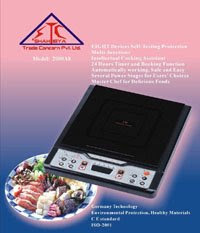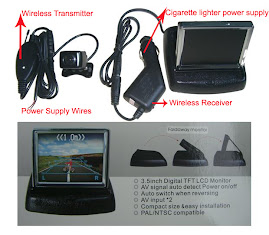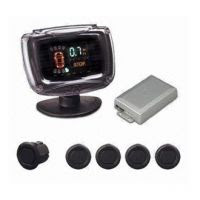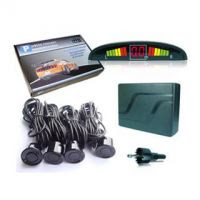1. On-off button; press this button to enter stood-by state displaying “ON” At this time press the function to enter working state. The indicator is bright.
2. Manual function’ for chaffy dish, barbecue and frying, power and temperature are adjustable with timing. Press big-small button to adjust power and temperature.
3. Auto function’ for heating milk, soup boiling, steaming and water boiling, Power temperature and timing are automatically set and finished. Pre-engage for starting can be got.
4. Press timing button’ timing from 1 min to 24 hours, displaying with count down.
No pan or wrong pan- displaying E0
Temperature controller open or short- displaying E1
Heat sensor of cooker face open or short- displaying E2
High pressure safeguard- displaying E3
Low pressure safeguard- displaying E4
Too high temperature- displaying E5
Too high temperature of radiator- displaying E6
auto function
(i) water, noodle or tea When the “water, noodle or tea” button is selected. The induction cooker will be on its condition and working. After done, it will be on the warming condition and then be off. Notice: 1. please use the pot with flat bottom. 2. When the “water, noodle or tea” button is selected, “up. down or timer” button will not work.
(ii) milk When the “milk” button is selected, the induction cooker will be on its condition and working. After done, it will be on the warming condition and then be off. Notice” When the “milk button is selected, “up .down or timer” button will not work.
(iii) When the “soup” button is selected, the induction cooker will be on its condition and working. After done, it will be on the warming condition and then be off. Notice: 1. please use the pot with flat bottom. 2. When the “soup” button is selected. “up .down or timer” button will not work.
(iv) gruel When the “gruel” button is selected, the induction cooker will be on its condition and working. After done, it will be on the warming condition and then be off. Notice: 1. please use the pot with flat bottom. 2. When the “braise” button is selected, “up .down or timer” button will not work. 3. Put enough water in the pot.
(v) braise When the “braise” the induction cooker will be on its condition and working. After done, it will be on the warming condition and then be off. Notice: 1. please use the pot with flat bottom. 2. When the “braise” button is selected, “up .down or timer” button will not work.
(vi) manual function 1. stir-fry on the readiness or heating , select the “stir-fry” button, the induction cooker will be on its condition and working, when the function is on, “up” “down” and “timer” buttons are all available. 2. barbecue on the readiness or heating, select the “barbecue” button, the induction cooker will be on its condition and working, when the function is on, “up” “down” and “timer” buttons are all available. 3. hotpot on the readiness or heating, select the “hotpot” button, the induction cooker will be on its condition and working, when the function is on, “up” “down” and “timer” buttons are all available.
(vii) timer 1. When the manual function is on, select “ timer” button to set the time for being off. 2. press the button of “timer” with longer time, then the “timer” will be off.
(viii) booking/reserve when the auto function is on, select “booking/reserve” button to set the time for being on.
(ix) Voltage on the readiness or heating, select the “voltage” button, the voltage which being used during this time will be displayed.
(x) energy on the readiness or heating, select the “energy” button, the electrical energy which had been consumed during this time will be displayed. A. Heating Principle On the principle of electromagnet induction coil under ceramics is electrified and produces magnetic lines of force which pass through the bottom of an iron pan, are shorted, produce strong vortex and heat the bottom. So food is heated. B. Characteristic of This Induction Cooker i. Effective and economical on energy This induction cooker is controlled by micro-computer transits electricity energy into high wave,
(xi) magnetic lines of force pass through the bottom of a pan, and hot electric vortex is produced, There is less midterm agent and best heat efficiency. Heat efficiency of induction cooker is highest than 80% Cost for energy is a half less than common cookers. ii. Easy operation because of controlling by micro computer and displaying. By nixie tube. iii. Health and environmental protection. Using this induction cooker, no smoke, no flame, no noise, no poison gas, no exhaust has and no interference with home electrical equipment, Beneficial to life and health. v. safety assure. 1. This induction cooker is not heated to small things. The pan is checked to prevent from overheat, over current, over pressure and deficient pressure, When the pan is overheat or there is too gig current change from voltage altering the induction cooker gives an alarm and stops heating automatically. 2. Power break after 45seconds, When no pan, a pan out of standard and mistaken use, the induction cooker turns off automatically. 3. The pan bottom of ferromagnetic material is heated and the cooker itself is not heated. So when touching the cooker carelessly, no burn happens. 4. The upper damage. No gas leakage, no explosion and the least danger.
(xii) Thanks for your purchasing our induction cooker. For your best understanding and right using, and for your enjoying modern life, please read the Specification before your using the article. 1. Notice for using site A. Not near water source to prevent water into the body to bring damage or to shorten life. B. The cooker used is 10cm from walls to prevent suction port or vent port from blocking. C. Apart from Heat air, steam or moisture in use. D. Do no put metallic things, magnetic things, such as watch, credit card, radio-recorder and disk, on the cooker to prevent magnetic field influence. 2.Safety in using A. Do use at least 15A separate socket., Do not use together with other electric equipment,. Because multi-hole-socket might heat to bring danger. B. Do not put any things on the face of the cooker except cooking pan. Specially this and so on, which might expand or explode. C. Do not put stannic paper directly or indirectly for heating to avoid danger. D. Do not put dishcloth, paper, cushion and so on, on the face of the cooker to heat indirectly to avoid too high temperature in the bottom of the cooker to bring burning. E. Do avoid steel wire into the suction port or vent port to avoid danger. F. K not hit ceramic face board. If any break, turn off immediately. Notice A. Connector plug is pulled out when the Induction cooker is not used. B. Keep clean whole cooker to prevent cockroaches and others from entering the cooker so to bring fault. C. Do not wash the cooker with water or dip it in water to scrub. D. When there is dirt on the face or bottom please clean out to prevent difficulty in cleaning. E. Dust in the suction port is cleaned out by electric cleaner or a small cotton stick. If any oil stain, clean out by a toothbrush with some neutrality detergent. F. Do not wiped with organics solvent, benzene or other chemicals to prevent chemical reaction or body damage


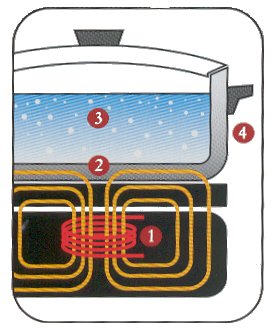
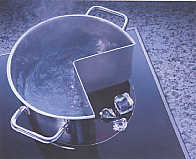

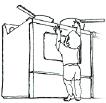
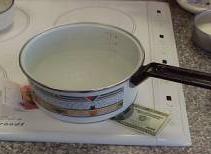
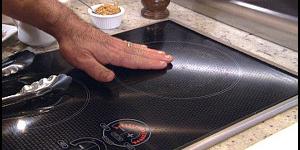 Furthermore, because its energy is transferred only to relatively massive magnetic materials, you can turn an induction element to "maximum" and place your hand flat over it with no consequences whatever--it will not roast your non-ferrous hand! (Nor any rings or bracelets--the units all have sensors that detect how much ferrous metal is in the area that the magnetic field would occupy, and if it isn't at least as much as a small pot, they don't turn on.) And, while an element is actually working, all of its energy goes into the metal cooking vessel right over it--there is none left "floating around" to heat up anything else. (The image at the right shows a hand--wearing a metal ring--harmlessly touching a full-on induction element, while a metal utensil lies equally harmlessly on another, emphatically demonstrating those points.)
Furthermore, because its energy is transferred only to relatively massive magnetic materials, you can turn an induction element to "maximum" and place your hand flat over it with no consequences whatever--it will not roast your non-ferrous hand! (Nor any rings or bracelets--the units all have sensors that detect how much ferrous metal is in the area that the magnetic field would occupy, and if it isn't at least as much as a small pot, they don't turn on.) And, while an element is actually working, all of its energy goes into the metal cooking vessel right over it--there is none left "floating around" to heat up anything else. (The image at the right shows a hand--wearing a metal ring--harmlessly touching a full-on induction element, while a metal utensil lies equally harmlessly on another, emphatically demonstrating those points.)  Moreover, gas--induction's only real competition--has special risks of its own, not all of which are as well known as they perhaps should be. While the risk of a gas flame, even a pilot light, blowing out and allowing gas to escape into the house is relatively small, it does exist. But a much bigger concern is simply gas itself, even when everything is working "right". Use any web search engine and enter the terms gas health risk cooking and see what you find (really: do try it right here); if, for example, you visit the Gascape web site, you may never again want to even enter a house with gas laid on (take some time to really poke around on this site--you may be shocked). And, of course, all combustion releases toxic carbon monoxide.
Moreover, gas--induction's only real competition--has special risks of its own, not all of which are as well known as they perhaps should be. While the risk of a gas flame, even a pilot light, blowing out and allowing gas to escape into the house is relatively small, it does exist. But a much bigger concern is simply gas itself, even when everything is working "right". Use any web search engine and enter the terms gas health risk cooking and see what you find (really: do try it right here); if, for example, you visit the Gascape web site, you may never again want to even enter a house with gas laid on (take some time to really poke around on this site--you may be shocked). And, of course, all combustion releases toxic carbon monoxide.